New Approach Evaluating Peatland Fires in Indonesian Factors
Abstract
:1. Introduction
2. Study Area and Data
2.1. Study Area
2.2. Various Data
2.2.1. Hotspot (Fire) Data
2.2.2. OLR–MC Index
2.2.3. Rainfall Data
2.2.4. Ground Water Level (GWL) Data
2.2.5. ENSO Data
3. Ground Water Level (GWL) Simulation (MODEL 0)
4. Results
4.1. Annual Hotspot (Fire) Trend in Kalimantan
4.2. Effective Fire Index (Comparison of OLR–MC and Niño 3.4)
4.2.1. OLR–MC Index
4.2.2. Niño 3.4 Index
4.2.3. Comparison of OLR–MC and Niño 3.4
4.3. Comparison of Rainfall Data
4.3.1. Estimated Rainfall using OLR
4.3.2. Rainfall during Dry Season
4.4. Fire Occurrence Trends in Fire Years
4.5. Hotspot (Fire) Simulation (MODEL-0)
4.5.1. Simulation (MODEL-0) Results for Fire Years
4.5.2. Simulation (MODEL-0) Results for 2015 (top) & 2006 (2nd)
4.5.3. Simulation (MODEL-0) Results for 2019 (3rd)
5. Discussion
5.1. Predictive Indicators Other than ENSO Indices for Active Peatland Fires
5.2. Groundwater Level (GWL) Prediction Model ((MODEL-0))
6. Conclusions
- (1)
- OLR–MC (monitoring convective activity in Indonesia using a rain-related index derived from the OLR) index is introduced as one of the fire indices for predicting peatland fire occurrence. The OLR–MC index showed a stronger correlation with active peatland fires than the conventional ENSO index and is likely to be able to respond to future fire forecasts supposed to be under climate change conditions (Figure 2 and Figure 3).
- (2)
- From the average fire trends in the top six fire years (El Niño years), excluding 2019, it was revealed that active fires occurred in three stages (Figure 8).
- (3)
- The one-dimensional GWL prediction model (MODEL-0) is introduced to define three fire stages of the active peatland fire years (Figure 8).
- (4)
- Peatland fire activities during three fire stages were dependent on the GWL-predicted values. Their GWL boundary values were ca. −300 mm and ca. −500 mm. Three fire stages are called surface fire, shallow peatland fire and deep peatland fire (Figure 8).
- (5)
- (6)
- The 2019 fires under neutral El Niño conditions also occurred in three fire stages defined by the estimated GWL using MODEL-0 and became very intense (ca. 270 HS day−1) in September (Figure 11). The 2019 case demonstrated how effective MODEL-0 was in forecasting GWL. In other words, the peatland fire situation (fire stages 1‒3) can be ascertained by the GWL value derived from MODEL-0. In particular, it is important to predict the occurrence of deep peatland fires (fire stage 3) and MODEL-0 could predict it.
- (7)
Author Contributions
Funding
Acknowledgments
Conflicts of Interest
References
- Page, S.; Rieley, J.; Hoscilo, A.; Spessa, A.; Weber, U. Current fire regimes, impacts and the likely changes—IV: Tropical Southeast Asia. In Vegetation Fires and Global Change—Challenges for Concerted International Action. A White Paper Directed to the United Nations and International Organizations; Goldberg, J.G., Ed.; Kessel Publishing House, KesselsKramer: Amsterdam, The Netherlands, 2013; pp. 91–96. [Google Scholar]
- Weisse, M.; Goldman, L. 2017 Was the Second-Worst Year on Record for Tropical Tree Cover Loss. Global Forest Watch Blog. Available online: https://blog.globalforestwatch.org/data-and-research/2017-was-the-second-worst-year-on-record-for-tropical-tree-cover-loss (accessed on 6 May 2020).
- Langner, A.; Siegert, F. Spatiotemporal fire occurrence in Borneo over a period of 10 years. Glob. Chang. Biol. 2009, 15, 48–62. [Google Scholar] [CrossRef]
- Schindele, W.; Thoma, W.; Panzer, K. The forest fire 1982/3 in East Kalimantan, Part 1: The fire, the effects, the damage and technical solutions. In FR-Report No. 5: Investigation of the Steps Needed to Rehabilitate the Areas of East Kalimantan Seriously Affected by Fire; Jakarta, German Forest Inventory Service Ltd. for German Agency for Technical Cooperation (GTZ) and International Tropical Timber Organization (ITTO): Yokohama, Japan, 1989. [Google Scholar]
- Lennertz, R.; Panzer, K. Preliminary assessment of the drought and forest fire damage in Kalimantan Timur. In East Kalimantan; Jakarta, DFS German Forest Inventory Service Ltd. for Deutsche Gesellschaft fur Technische Zusammenarbeit (GTZ): Bonn and Eschborn, Germany, 1984. [Google Scholar]
- Tacconi, L. Fires in Indonesia: Causes, Costs and Policy Implications; CIFOR Occasional Paper No. 38; CIFOR: Bogor, Indonesia, 2003. [Google Scholar]
- Reuters. Greenpeace Blasts Indonesia for not Imposing Tough Penalties for Forest Fires. 2019. Available online: https://www.nst.com.my/world/2019/09/524250/greenpeace-blasts-indonesia-not-imposing-tough-penalties-forest-fires (accessed on 18 January 2020).
- Jakarta Post. Fires in Indonesia Burn 1.6m ha of Land, Mostly Former Forests: Satellite Data. Available online: https://www.thejakartapost.com/life/2019/12/02/fires-in-indonesia-burn-1-6m-ha-of-land-mostly-former-forests-satellite-data.html (accessed on 18 January 2020).
- Liebmann, B.; Marengo, J.A.; Glick, J.D.; Kousky, V.E.; Wainer, I.C.; Massambani, O. A Comparison of Rainfall, Outgoing Longwave Radiation, and Divergence over the Amazon Basin. J. Clim. 1998, 11, 2898–2909. [Google Scholar] [CrossRef]
- Lim, E.S.; Wong, C.J.; Abdullah, K.; Poon, W.K. Relationship between outgoing longwave radiation and rainfall in South East Asia by using NOAA and TRMM satellite. In Proceedings of the 2011 IEEE Colloquium on Humanities, Science and Engineering, Penang, Malaysia, 5–6 December 2011. [Google Scholar]
- Hoscilo, A.; Page, S.E.; Tansey, K.J. Repeated and extensive fire as the main driver of land cover change in Block C of the former Mega Rice Project. In Proceedings of the 13th International Peat Congress: After Wise Use—the Future of Peatlands; Farrell, C., Feehan, J., Eds.; International Peat Society: Tullamore, Ireland, 2008; pp. 206–208. [Google Scholar]
- Hoscilo, A.; Page, S.E.; Wosten, H.; Jauhiainen, J.; Silvius, M.; Rieley, J.; Ritzema, H.; Tansey, K.; Graham, L.; Vasander, H. Restoration ecology of lowland tropical peatlands in Southeast Asia: Current knowledge and future research directions. Ecosystems 2008, 12, 888–905. [Google Scholar]
- Page, S.E.; Hoscilo, A.; Langner, A.; Tansey, K.J.; Siegert, F.; Limin, S.; Rieley, J.O. Tropical peatland fires in Southeast Asia. In Tropical Fire Ecology: Climate Change, Land Use and Ecosystem Dynamics; Cochrane, M.A., Ed.; Springer: Berlin/Heidelberg, Germany, 2009. [Google Scholar]
- Vetrita, Y.; Cochrane, M.A. Fire frequency and related land-use and land-cover changes in Indonesia’s peatlands. Remote Sens. 2019, 12, 5. [Google Scholar] [CrossRef] [Green Version]
- Schultz, M.G.; Heil, A.; Hoelzemann, J.J.; Spessa, A.; Thonicke, K.; Goldammer, J.G.; Held, A.C.; Pereira, J.M.C.; van het Bolscher, M. Global wildland fire emissions from 1960 to 2000. Glob. Biogeochem. Cycles 2008, 22, 1–17. [Google Scholar] [CrossRef]
- Van der Werf, G.R.; Randerson, J.T.; Giglio, L.; Collatz, G.J.; Kasibhatla, P.S. Interannual variability in global biomass burning emission from 1997 to 2004. Atmos. Chem. Phys. 2006, 6, 3423–3441. [Google Scholar] [CrossRef] [Green Version]
- Setyawati, W.; Suwarsono. Carbon emission from peat fire in 2015. IOP Conf. Ser. Earth Environ. Sci. 2018, 166, 1–7. [Google Scholar] [CrossRef] [Green Version]
- Kiely, L.; Spracklen, D.V.; Wiedinmyer, C.; Conibear, L.; Reddington, C.L.; Archer-Nicholls, S.; Lowe, D.; Arnold, S.R.; Knote, C.; Khan, M.F. New estimate of particulate emissions from Indonesian peat fires in 2015. Atmos. Chem. Phys. 2019, 19, 11105–11121. [Google Scholar] [CrossRef] [Green Version]
- Hayasaka, H.; Noguchi, I.; Putra, E.I.; Yulianti, N.; Vadrevu, K. Peat fire-related air pollution in Central Kalimantan. Environ. Pollut. 2014, 195, 257–266. [Google Scholar] [CrossRef] [PubMed]
- Lin, S.; Sun, P.; Huang, X. Can peat soil support a flaming wildfire? Int. J. Wildland Fire 2019, 28, 601–613. [Google Scholar] [CrossRef]
- Usup, A.; Hashimoto, Y.; Takahashi, H.; Hayasaka, H. Combustion and thermal characteristics of peat fire in tropical peatland in Central Kalimantan, Indonesia. Tropics 2004, 14, 1–19. [Google Scholar] [CrossRef] [Green Version]
- Huang, X.; Rein, G. Upward-and-downward spread of smoldering peat fire. Proc. Combust. Inst. 2019, 37, 4025–4033. [Google Scholar] [CrossRef]
- Hayasaka, H.; Sepriando, A. 2015 severe peat fires and air pollution near the former mega rice project area in Central Kalimantan, Indonesia. In Proceedings of the 15th International Peat Congress 2016; Curran Associates: New York, NY, USA, 2015; pp. 323–326. [Google Scholar]
- Wetlands International, Wageningen, The Netherlands. Available online: https://www.wetlands.org (accessed on 17 January 2020).
- Pusat Database—BMKG. Jakarta, Indonesia. Available online: http://dataonline.bmkg.go.id/akses_data (accessed on 17 January 2020).
- Japan Aerospace Exploration Agency. Tokyo: JAXA. Available online: https://sharaku.eorc.jaxa.jp/GSMaP/index.html (accessed on 18 January 2020).
- National Oceanic and Atmospheric Administration. Washington: NOAA. Available online: https://www.esrl.noaa.gov/psd/data/gridded/data.uninterp_OLR.html (accessed on 17 January 2020).
- Liebmann, B.; Smith, C.A. Description of a Complete (Interpolated) Outgoing Longwave Radiation Dataset. Bull. Am. Meteorol. Soc. 1996, 77, 1275–1277. [Google Scholar]
- National Oceanic and Atmospheric Administration. Washington: NOAA. Available online: https://www.esrl.noaa.gov/psd/data/gridded/data.interp_OLR.html (accessed on 17 January 2020).
- Putra, E.I.; Hayasaka, H. The effect of the precipitation pattern of the dry season on peat fire occurrence in the Mega Rice Project area, Central Kalimantan, Indonesia. Tropics 2011, 19, 145–156. [Google Scholar] [CrossRef] [Green Version]
- National Oceanic and Atmospheric Administration. Washington: NOAA. Available online: http://www.cpc.ncep.noaa.gov/data/indices (accessed on 17 January 2020).
- Susilo, G.E.; Yamamoto, K.; Imai, T. Modeling groundwater level fluctuation in the tropical peatland areas under the effect of El Nino. Procedia Environ. Sci. 2013, 17, 119–128. [Google Scholar] [CrossRef] [Green Version]
- Maréchal, J.C.; Dewandel, B.; Ahmed, S.; Galeazzi, L.; Zaidi, F.K. Combined estimation of specific yield and natural recharge in semi-arid groundwater basin with irrigated agriculture. J. Hydrol. 2006, 329, 281–293. [Google Scholar] [CrossRef] [Green Version]
- Hayasaka, H. Predicting rainfall using outgoing longwave radiation (OLR) and peat fires in Indonesia. Hokkaido Branch J. Japan Meteorol. Soc. 2019, 65, 1–2. (In Japanese) [Google Scholar]
- Hayasaka, H.; Takahashi, H.; Limin, S.H.; Yulianti, N.; Usup, A. Peat Fire Occurrence, chapter 25. In Tropical Peatland Ecosystems; Mitsuru, O., Nobuyuki, T., Eds.; Springer: Berlin/Heidelberg, Germany, 2016; pp. 377–395. ISBN 978-4-431-55681-7. [Google Scholar]
- Babrauskas, V. Ignition Handbook; Fire Science Publishers: Issaquah, WA, USA, 2003. [Google Scholar]
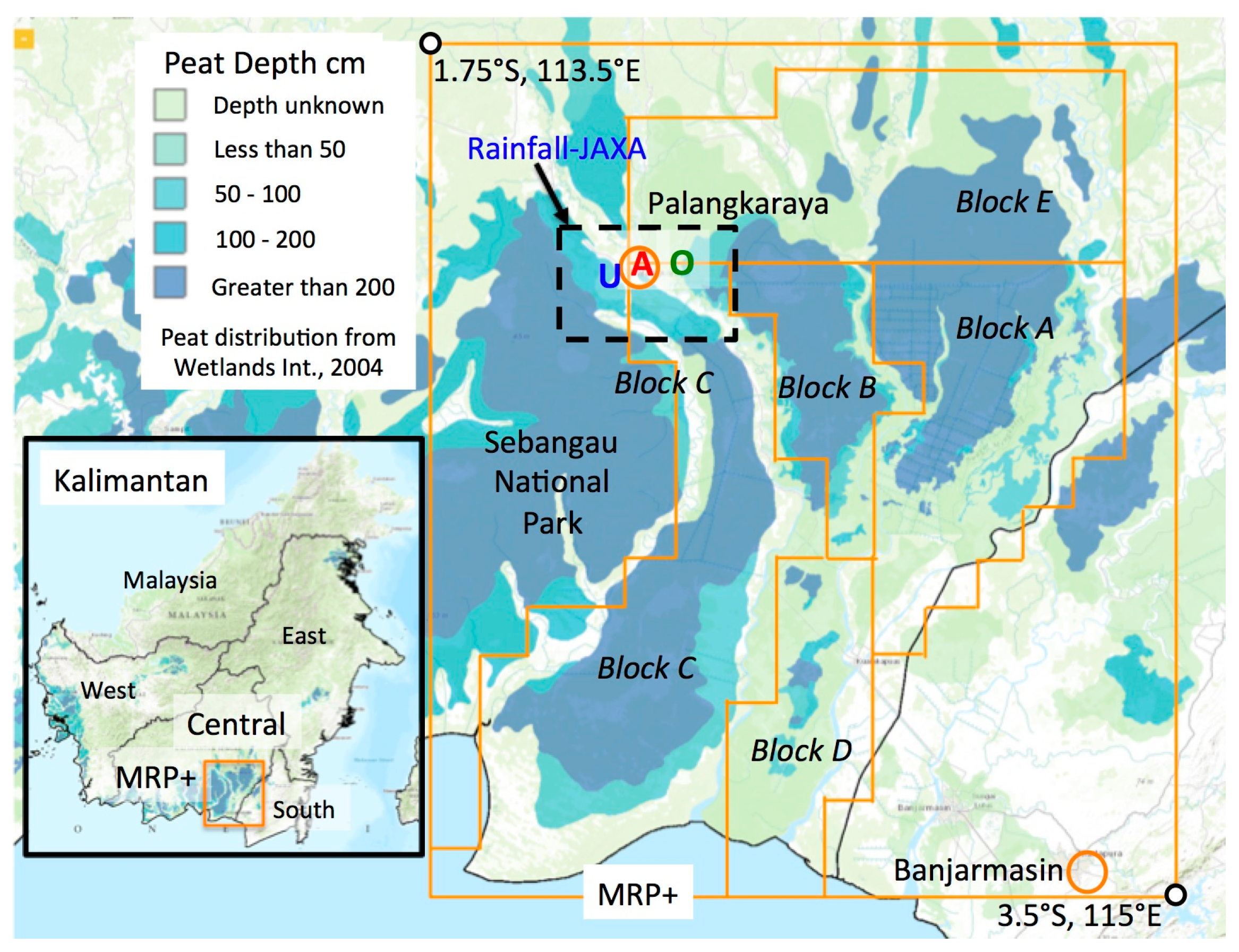
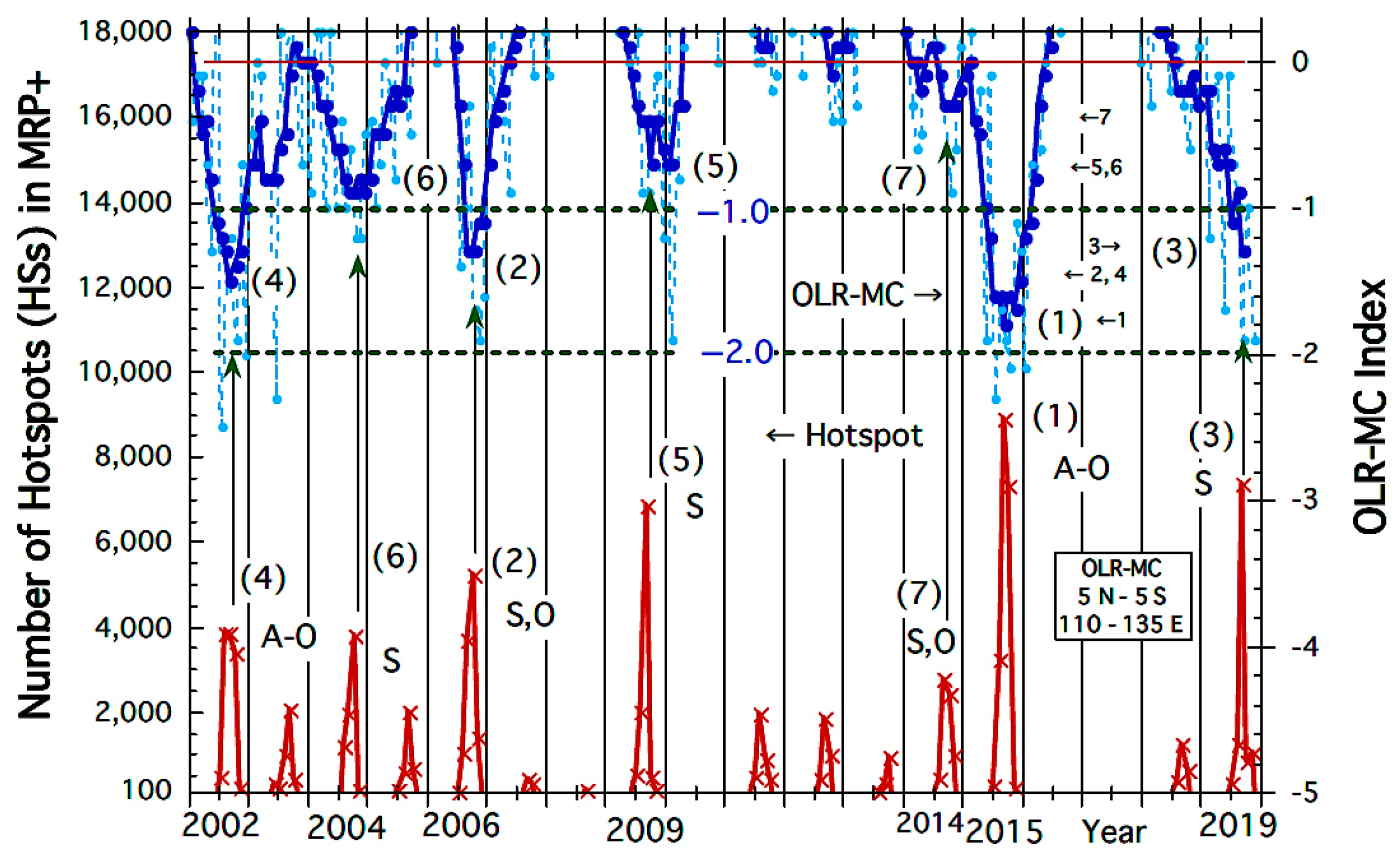
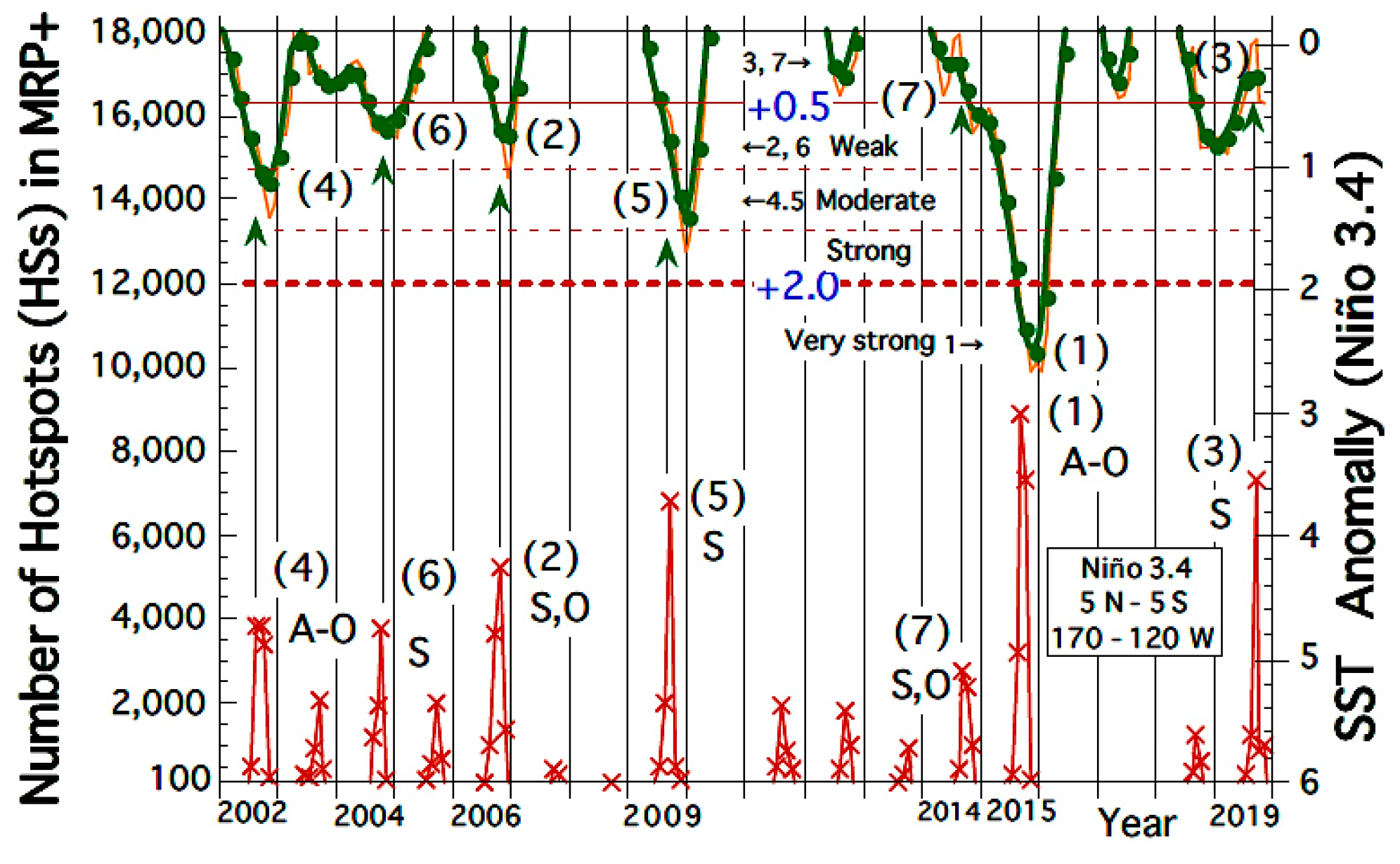
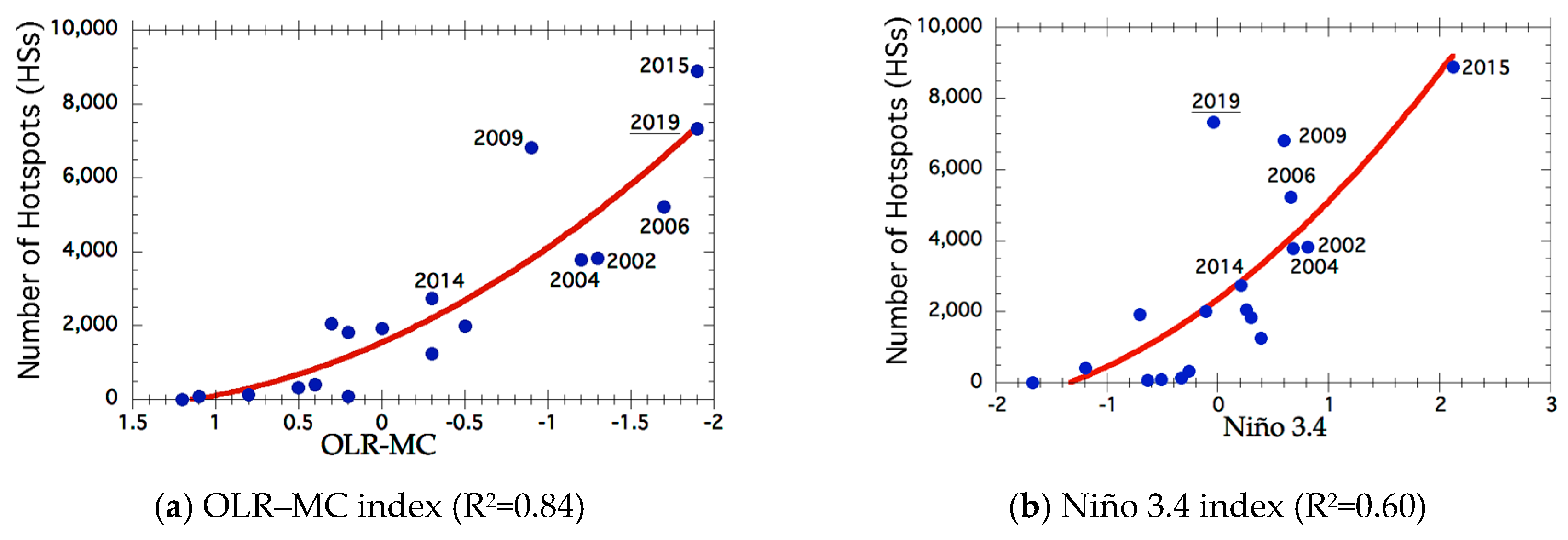
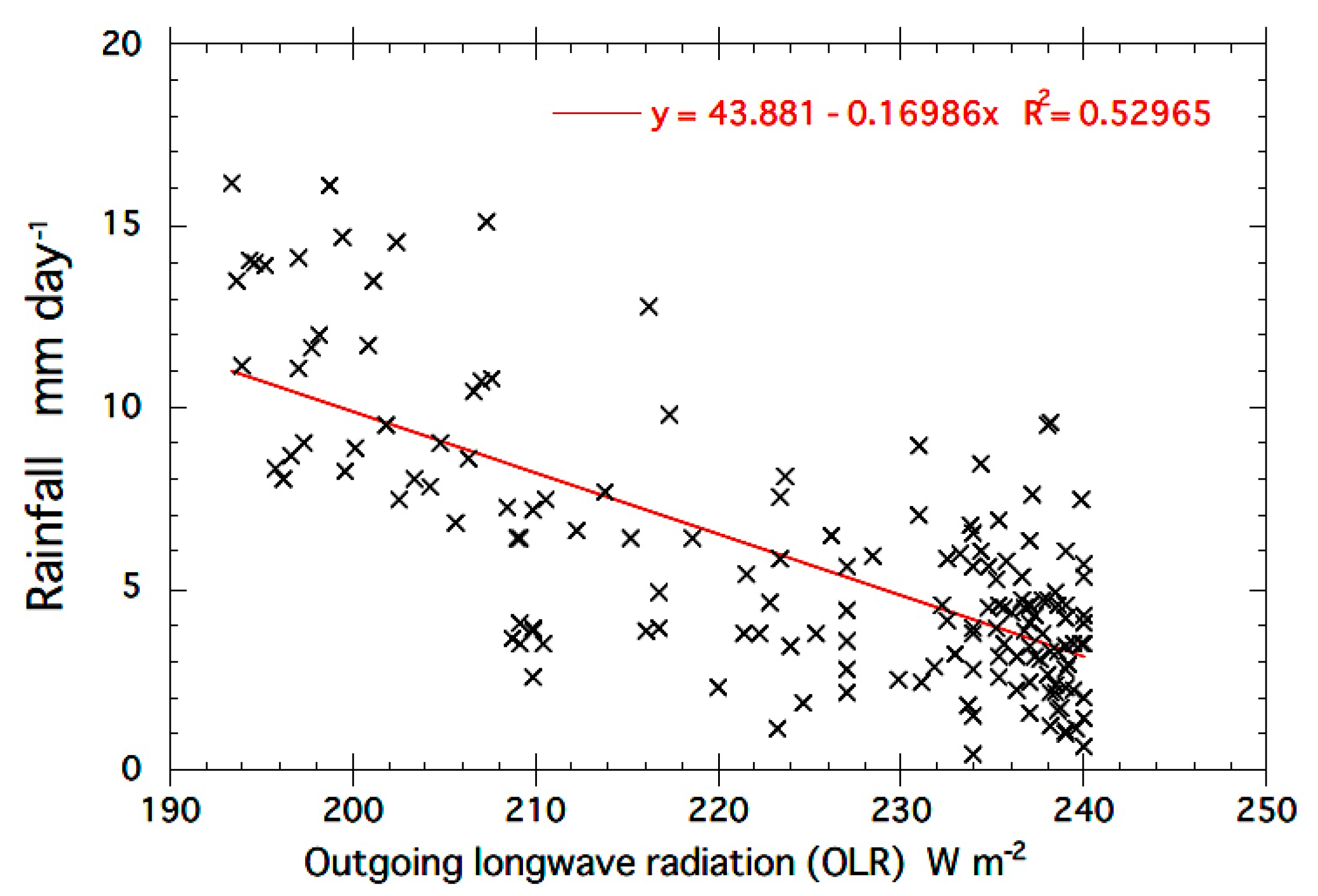
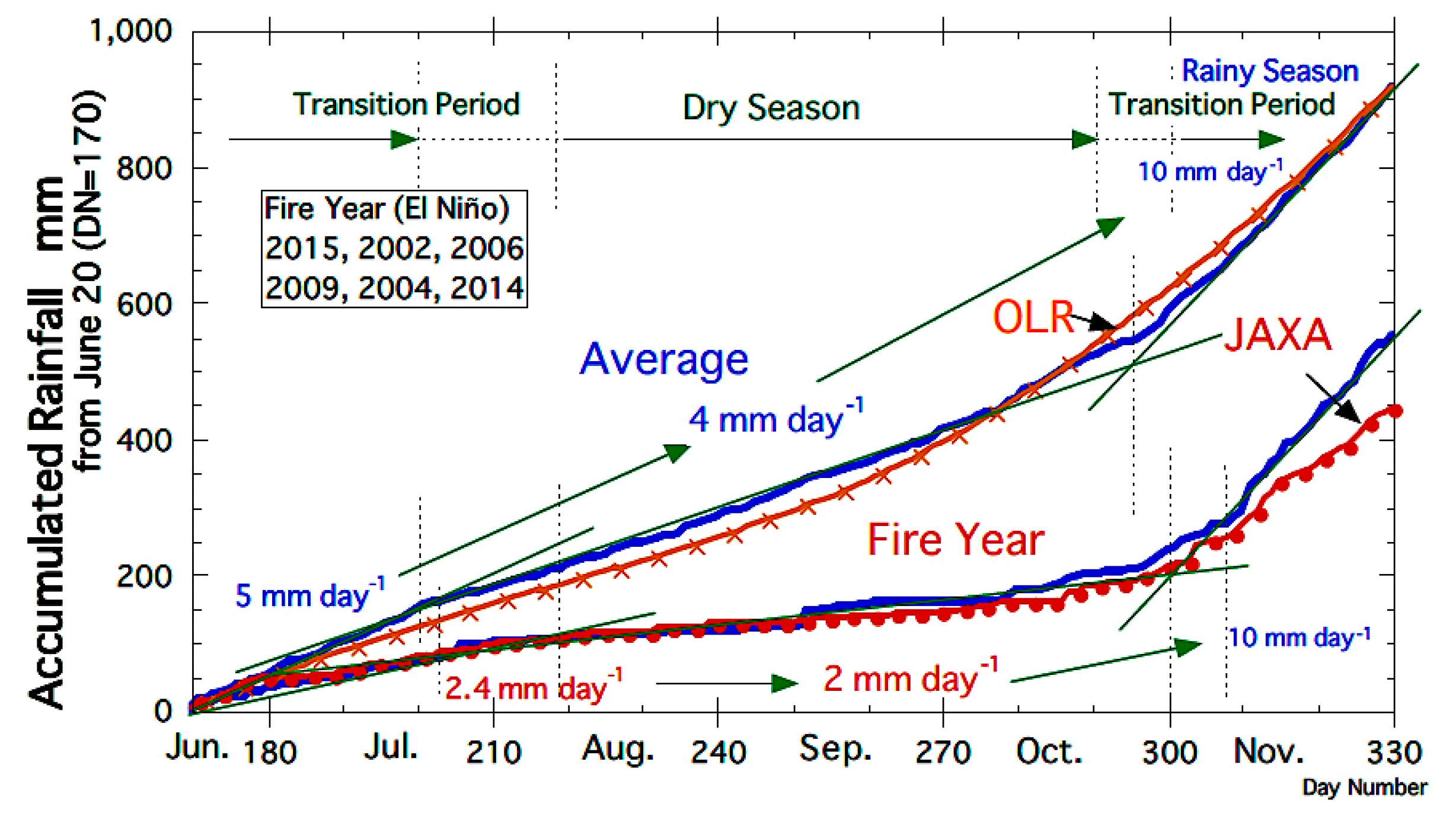




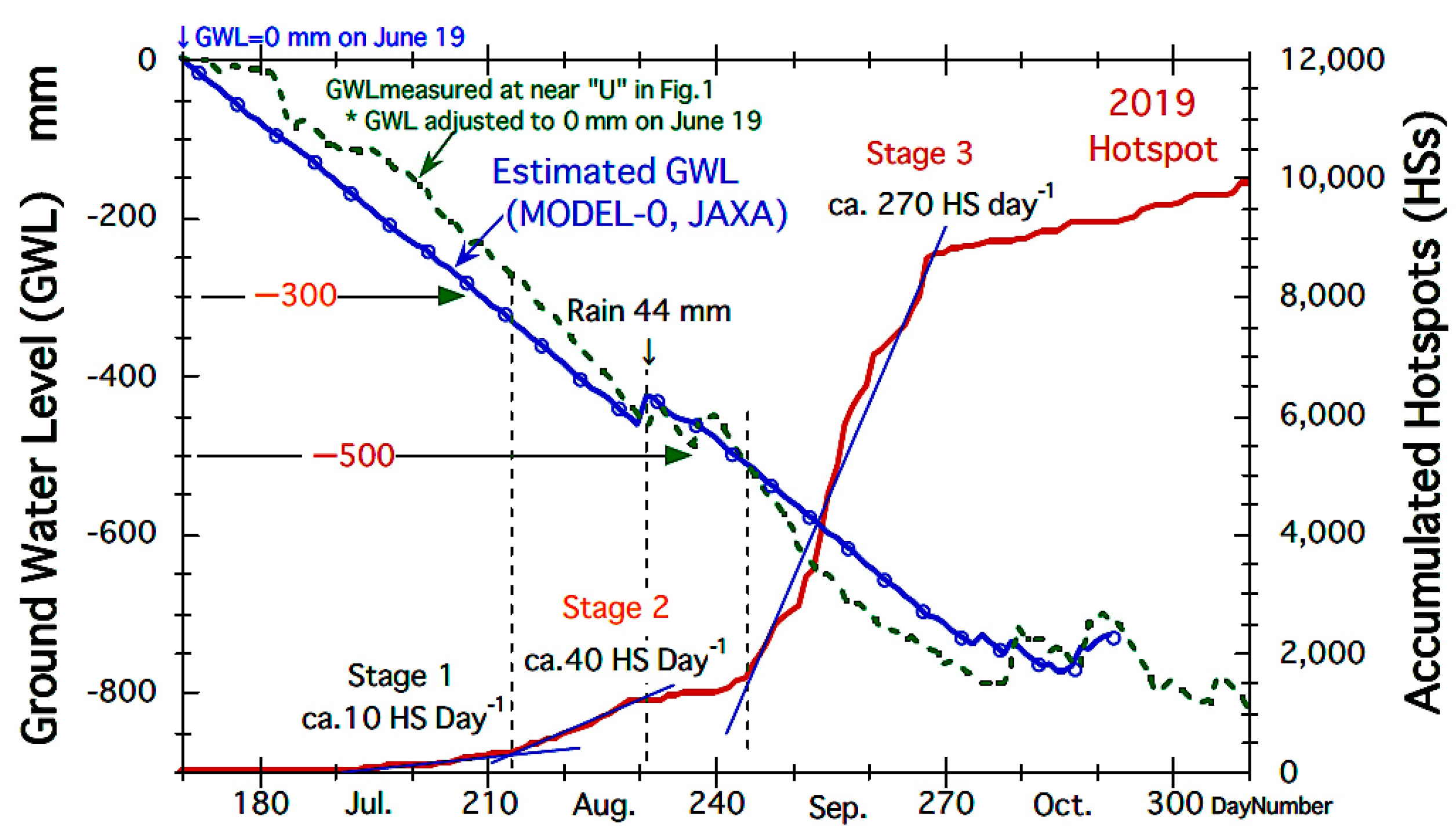
| Year | Niño 3.4 1 | OLR–MC 1 |
|---|---|---|
| 1972–73 | 2.17 | none |
| 1982–83 | 2.09 | −2.3 |
| 1994 | 1.19 | −0.8 |
| 1997–98 | 2.48 | −1.8 |
| 2002 | 1.41 | −0.7 |
| 2006 | 1.09 | −1.9 |
| 2015 | 2.67 | −1.1 |
| 2019 | 0.48 | −1.9 |
| Rank | Year | (1) HS MRP+ | (2) HS Kalimantan | (1)/(2)% | Rank | Year | (1) HS MRP+ | (2) HS Kalimantan | (1)/(2)% |
|---|---|---|---|---|---|---|---|---|---|
| 1 | 2015 | 19,936 | 78,708 | 25.3 | 10 | 2018 | 3452 | 16,892 | 20.4 |
| 2 | 2006 | 11,754 | 55,852 | 21.0 | 11 | 2011 | 3351 | 17,097 | 19.6 |
| 3 | 2019 1 | 11,070 | 42,714 | 25.9 | 12 | 2003 | 2367 | 18,612 | 12.7 |
| 4 | 2002 | 10,745 | 46,487 | 23.1 | 13 | 2013 | 1451 | 12,225 | 11.9 |
| 5 | 2009 | 10,044 | 40,830 | 24.6 | 14 | 2007 | 810 | 11,263 | 7.2 |
| 6 | 2004 | 7220 | 36,333 | 19.9 | 15 | 2017 | 311 | 5371 | 5.8 |
| 7 | 2014 | 6677 | 32,384 | 20.6 | 16 | 2016 | 214 | 11,003 | 1.9 |
| 8 | 2012 | 4025 | 19,212 | 21.0 | 17 | 2008 | 164 | 8150 | 2.0 |
| 9 | 2005 | 3747 | 16,249 | 23.1 | 18 | 2010 | 85 | 6128 | 1.4 |
| Total | 97,423 | 475,510 | 20.5 | ||||||
© 2020 by the authors. Licensee MDPI, Basel, Switzerland. This article is an open access article distributed under the terms and conditions of the Creative Commons Attribution (CC BY) license (http://creativecommons.org/licenses/by/4.0/).
Share and Cite
Hayasaka, H.; Usup, A.; Naito, D. New Approach Evaluating Peatland Fires in Indonesian Factors. Remote Sens. 2020, 12, 2055. https://doi.org/10.3390/rs12122055
Hayasaka H, Usup A, Naito D. New Approach Evaluating Peatland Fires in Indonesian Factors. Remote Sensing. 2020; 12(12):2055. https://doi.org/10.3390/rs12122055
Chicago/Turabian StyleHayasaka, Hiroshi, Aswin Usup, and Daisuke Naito. 2020. "New Approach Evaluating Peatland Fires in Indonesian Factors" Remote Sensing 12, no. 12: 2055. https://doi.org/10.3390/rs12122055
APA StyleHayasaka, H., Usup, A., & Naito, D. (2020). New Approach Evaluating Peatland Fires in Indonesian Factors. Remote Sensing, 12(12), 2055. https://doi.org/10.3390/rs12122055





